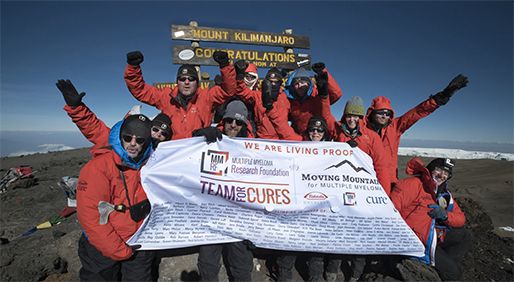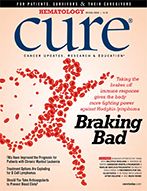Publication
Article
CURE
On Top of the World Fighting Multiple Myeloma
Author(s):
With its series of hikes, Moving Mountains for Multiple Myeloma inspires donations — and pride.
Mount Kilimanjaro

Mount Kilimanjaro
In September 2013, Donna Cowan received shocking news — she had high-risk multiple myeloma and would probably only live two or three more years.
She had previously been an active 70-year-old, but her disease created extremely painful bone lesions in her spine that made it difficult for her to move without help. Frustrated with her disability, she began to lose confidence in herself. It was the memory of her late first husband that inspired her to keep fighting.
“I watched my first husband die of cancer at 38, and it was so sad,” she says. “When I got diagnosed, I said, ‘Self, you can sit here and not do anything and let everyone else do it for you, and take what you need to take, or you can get up, and you can do whatever you can do to make your life better.’”
Cowan did just that, and by May 2016 — nearly three years after being told she only had a few years to live — she hiked the Bright Angel Trail in the southern rim of the Grand Canyon, one of the most difficult and iconic trails in the United States. “It was just beyond anything I ever dreamed I would be doing in my lifetime, absolutely beyond,” says Cowan, who was able to improve her quality of life after multiple myeloma treatment and regular exercise. “It’s so spiritual. You don’t feel threatened to be there. You just feel that it is all going to be OK. I know if I can do that, then I can do anything.”
Her hike was part of “Moving Mountains for Myeloma,” a program that brings together patients, caregivers, health care professionals, researchers and others connected to multiple myeloma to raise awareness and money for the treatment of the disease by participating in hikes all over the world. In addition to the Grand Canyon hike, which raised $45,000, the Moving Mountains program also organized a hike up Tanzania's Mount Kilimanjaro in January of this year that raised nearly $250,000, as well as a hike on the Inca Trail to Machu Picchu, Peru, in August 2016 that raised $155,000. All three hikes are planned again for 2017.
Proceeds from the Moving Mountains hikes, which are sponsored by Takeda Pharmaceuticals and CURE® Media Group, go toward the nonprofit Multiple Myeloma Research Foundation (MMRF). While there have been a lot of recent advancements in multiple myeloma, research funding is still desperately needed, says Alicia O’Neill, the director of business development and partnerships for MMRF events.
“Our sole purpose at MMRF is to fund and oversee research that gets these drugs through the pipeline faster so the patients can benefit,” says O’Neill, who participated in all three hikes. “It usually takes 10 years for one new drug to come to market, and now we’ve had 10 drugs in 12 years. Last year alone, four new drugs came to the market. The life expectancy of the average patient is now nine or 10 years, and maybe by then we will have a cure; it may be a manageable disease. There is a lot of hope, and it is hope based on progress.”
While the financial impact of the program has been significant, what is perhaps just as noteworthy is the emotional impact it has had on those who participate. Many of the patients, like Cowan, feel an intense sense of pride for accomplishing something so physically difficult after a cancer diagnosis. Jeff Stiles, who participated in the Machu Picchu climb, says he felt extremely blessed to have the opportunity to prove to himself that he could still take on anything, despite his multiple myeloma diagnosis.
“I got a stem cell transplant in January 2015, and I had to live in an apartment away from everyone I loved; I didn’t see my kids for about a month, and I could hardly get myself off the couch to walk outside,” says Stiles. “To go from the depths of just feeling like crud and being away from my family to being literally on top of a mountain, it was just something I never imagined happening. On the hike, people kept saying that they couldn’t tell who were the patients and who weren’t, and that was an incredible compliment.”
The Moving Mountains program also serves to give hope to those with multiple myeloma who did not participate in a hike. During the Mount Kilimanjaro climb, the patients back at home were a constant inspiration, says Chuck Wakefield, D.D.S., a Kilimanjaro hiker with multiple myeloma.
After facing subzero temperatures, dehydration and exhaustion, 11 of the 15 participating hikers made it to the summit of the world’s tallest freestanding mountain. Their first priority? Taking a photo in front of a banner with the names of multiple myeloma patients, as well as those who had lost their battle with the disease.
“There are not a whole lot of patients that are able to do something like this, so we were doing it for them, as well,” says Wakefield. “It meant so much to them to have their names on the banner.”
Bob Dickey, another patient with multiple myeloma who participated in the Mount Kilimanjaro climb, hopes that others are inspired by his climb to do whatever they set their minds to, with or without multiple myeloma. “Your life doesn’t have to be all about your next doctor’s appointment,” he says. “Don’t resign yourself to that; strive for the things you wanted before the disease. I have never been more optimistic about anything than I am about this. Multiple myeloma is considered incurable, but the way I see it, it is a lot more manageable than it used to be. We don’t talk about months or years of survival anymore; we talk about decades.”
MOTIVATION TO KEEP UP THE GOOD WORK
The impact of the Moving Mountains program has been felt by more than just patients with multiple myeloma. Many of the scientists, researchers, doctors and nurses that participated in the hikes say they walked away with increased motivation to excel at their jobs.
Karuppiah Kannan, a Takeda scientist who works in a lab designing and developing novel multiple myeloma drugs, called the experience of interacting with patients on his Grand Canyon hike “eye opening.” It takes at least 10 to 15 years from the time a scientist discovers something in the lab to the day a patient sees benefit, and sometimes when the days are long and the work is hard, it is easy to lose sight of just how important everything they do is, said Kannan.
Previous to going on the hike, Kannan sometimes got frustrated with the number of weekends, family events and holidays he missed due to his work. But once he talked to patients with multiple myeloma, his perspective changed. “On the hike, when I saw a patient and heard from them that they were able to celebrate another Thanksgiving with their family members that they didn’t think they would, I no longer felt bad about the holidays that I missed due to work,” he says. “That isn’t a big deal anymore. I met patients who, six months ago, were in the hospital, and now are on the hike with us. This shows that not only did we extend their lives, but we have given them enough strength and willpower to take on any challenge. That was never as apparent to me before as it is now.”
Paul Bassett, B.S.N., a clinical operations manager at MMRF who participated in the Machu Picchu climb, had a similar experience.
“I was sitting in Peru in a small café with a patient and his wife, and I hear, ‘I am on this drug and I am doing fine,’” says Bassett. “It is such an encouragement to what we are doing, and it makes you want to come in and work harder.”
Bassett had the unique experience of not only fundraising with the other hikers during his Machu Picchu journey, but also putting those dollars into action. Ninety percent of the funds raised on the hikes will go back into research at MMRF, and Bassett is on a team that determines exactly how that money is spent. Currently, MMRF has 18 clinical trials open at 22 different research sites, and eight more trials will be started this year, Basset says, adding that he was inspired by his experience to work even harder to start more trials, find more patients to be part of them, and help more patients live even longer with a better quality of life.
GROWING A NETWORK
The impact of the Moving Mountains program will continue far beyond the trips themselves, says Bassett. In just the three trips that have occurred so far, 46 hikers have participated, creating a network of people fighting multiple myeloma together that will only continue to grow as the program expands.
“We now have several groups of patients, doctors, nurses and loved ones coming together, sharing an experience and a common bond across all three teams,” says Bassett. “People of all ages, all backgrounds, all mindsets just came together in one united front, and we conquered these mountains.” This collaborative spirit can be applied to more than just hiking a mountain, says Stiles. Despite the hikes each consisting of people from different locales, experiences, ages and careers, each group worked together well as a team. This is what needs to happen across multiple myeloma as a whole, says Stiles.
“People coming together from various walks of life for one cause was very moving and motivating,” he says. “If we can do that for what was a comparatively easy task of climbing a mountain, can we not do the same to find a cure for this disease? This experience is symbolic of our struggle to find a cure. It is going take a lot of people from a lot of different backgrounds with a lot of different thinking to accomplish this, but I think we can.”




